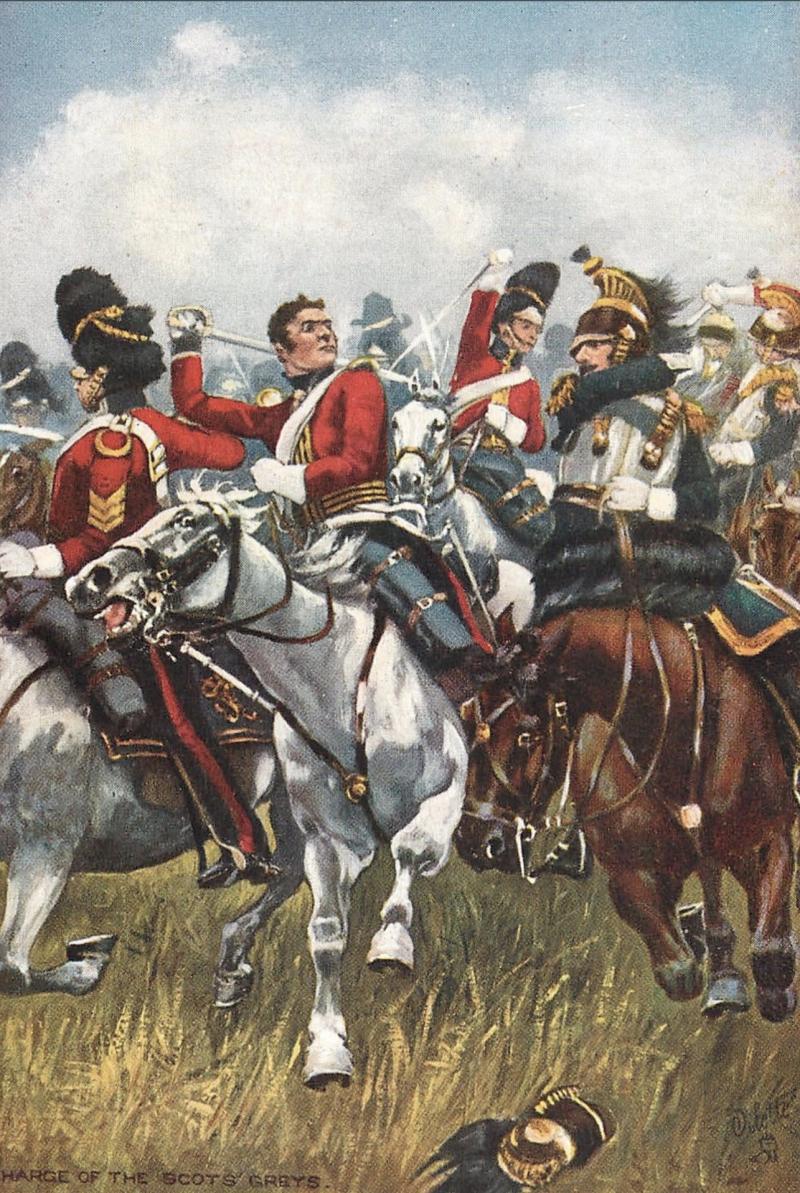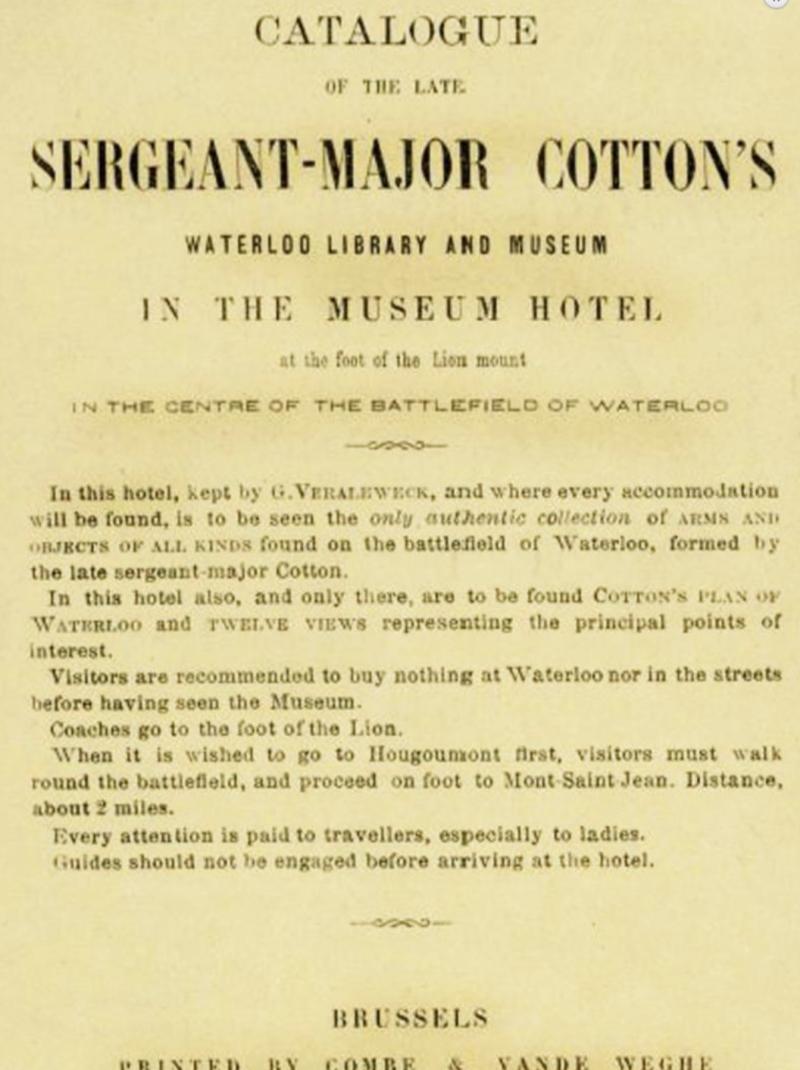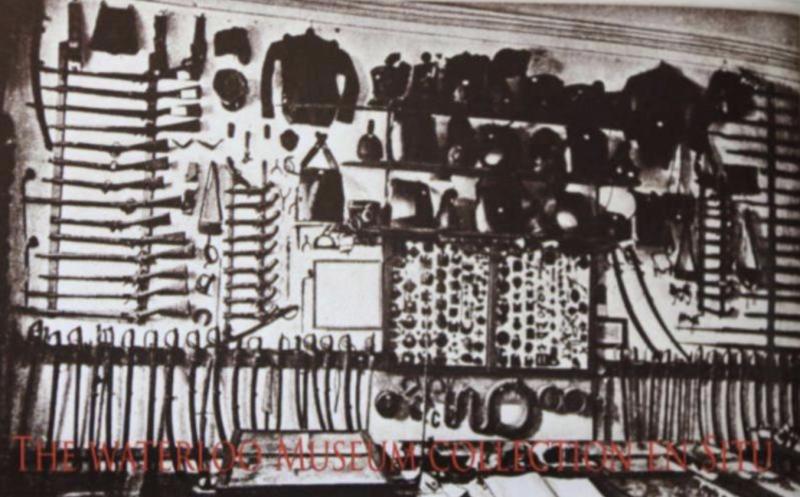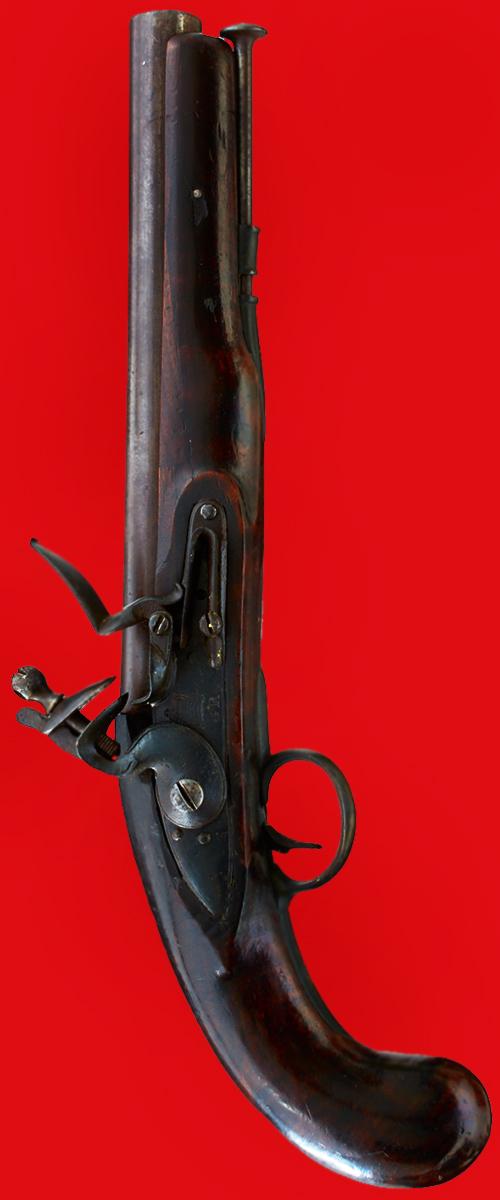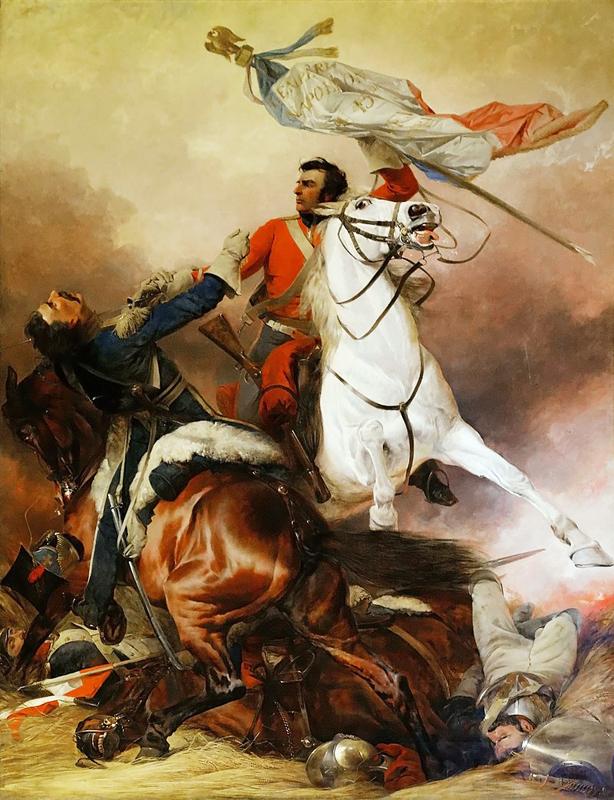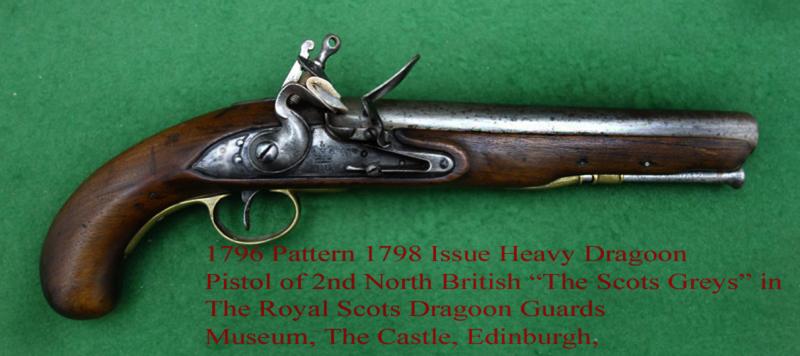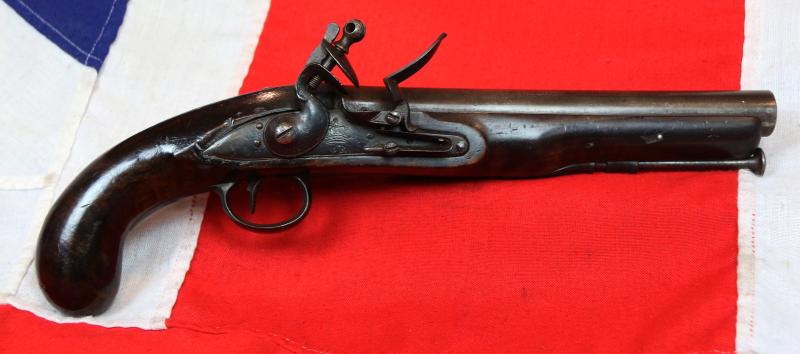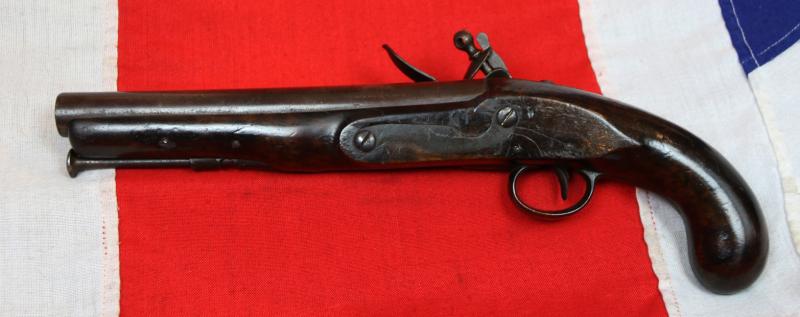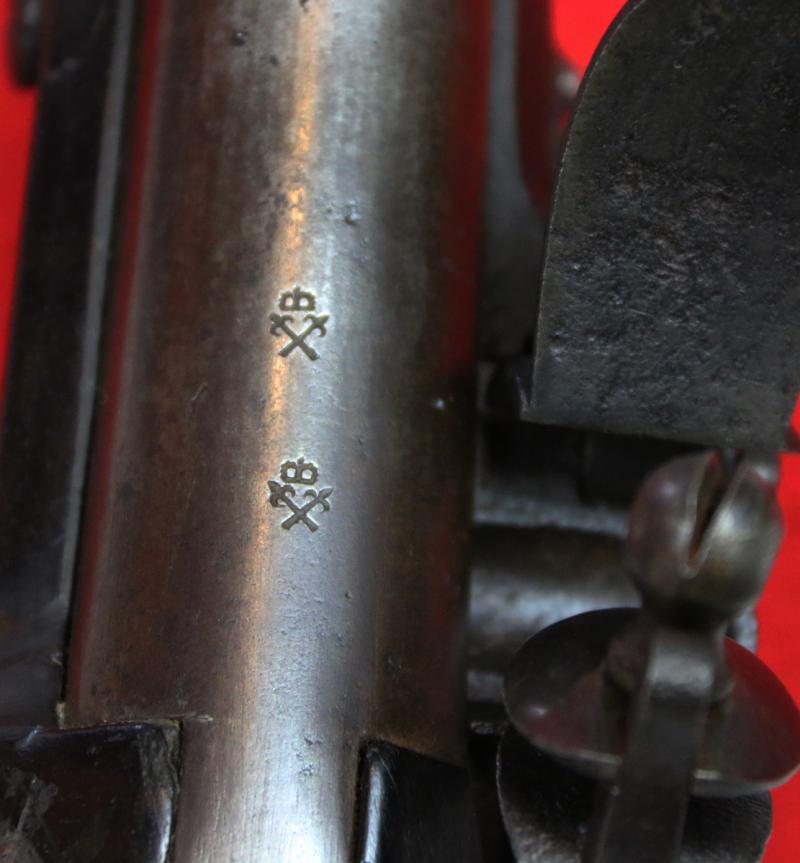Historical 1796 pat. Heavy Dragoon Trooper's Pistol, Tower of London Proofs, of Waterloo, Used by the Union & Household Brigade, Service Issue, .75 Upgraded Barrel Size Version of 1798. For Extra Penetrative Power Against French Cuirassiers Breast Armour
We were absolutely delighted to acquire both the Officer’s version and the 1798 upgraded .75 barrel version for troopers, {this pistol} proved at the Tower of London armoury. Both as used by The Union or Household Brigade At Waterloo. They are absolute historical beauties. Prime examples of original, rare, Napoleonic War service used antiques. We are very privileged to be the UK’s premier original military antiques gallery and website, and to be able to consistently, continually, and regularly, offer the finest original collectors items in our shop for over 100 years
This stunning service flintlock is in very nice order indeed, with wonderful natural age patina, and good tight action, .75 inch bore barrel with 1801 issue steel service ramrod, and clear barrel proofs, brass furniture and finest walnut stock. Lock with service GR Crown stamp, likely traces of feint Tower mark upon the lock plate tail, behind the cock.
In 1796 a Board of General Officer's met to charge Henry Nock to design and develop a Heavy Dragoon pistol of Carbine bore. He came up with a heavy 9 inch barrel flintlock pistol, with no brass butt cap, and a separate steel rammer to be stored on the holster saddle bucket rather than creating a standard channel underneath it's barrel as in the light dragoon pistol. This was changed to accept a steel ramrod in 1801. Only one pistol was to be issued to each trooper, as opposed to the light cavalry trooper being issued with a brace a pair. Subsequent to 1801, the pistols made thereafter were to receive the all iron rammer under the barrel within a channel, on occasion to be retained by an internal spring. The bores initially were to be 16 bore, but they were changed to 14.5 bore and then 10 bore, the same as the Brown Bess musket. The bore size increase was due to the fact that the opposing French Heavy Cavalry were armoured unlike the British and carbine bore calibre pistols were simply not powerful enough within the mass inertia of the lead ball to penetrate plate armour. This is the pattern of pistol used by all the great Heavy Dragoon regiments, such as the Royal North British Dragoons, The Inniskillin Dragoons. The 1796 Heavy Dragoon pattern pistols as were all other patterns were supplied in large numbers to the British ordnance by makers Nock and Ketland, as manufacture by the Tower was relatively slow, for, during the Napoleonic Wars, need for arms was far greater than the Tower could supply. The two heavy cavalry brigades called the Household Brigade and the Union Brigade saw famous service at the peak of the Battle of Waterloo, and most famously just before 2.00pm. At this crucial juncture, Uxbridge ordered his two brigades of British heavy cavalry, formed unseen behind a ridge, to charge in support of the hard-pressed infantry. The 1st Brigade, known as the Household Brigade, commanded by Major-General Edward Somerset (Lord Somerset), consisted of guards regiments: the 1st and 2nd Life Guards, the Royal Horse Guards (the Blues), and the 1st (King's) Dragoon Guards. The 2nd Brigade, also known as the Union Brigade, commanded by Major-General Sir William Ponsonby, was so called as it consisted of an English, the 1st (The Royals); a Scottish, 2nd ('Scots Greys'); and an Irish, 6th (Inniskilling); regiment of heavy dragoons. More than 20 years of warfare had eroded the numbers of suitable cavalry mounts available on the European continent; this resulted in the British heavy cavalry entering the 1815 campaign with the finest horses of any contemporary cavalry arm. They also received excellent mounted swordsmanship training. They were, however, inferior to the French in maneuvering in large formations, cavalier in attitude, and unlike the infantry had scant experience of warfare. According to Wellington, they had little tactical ability or common sense. The two brigades had a combined field strength of about 2,000 (2,651 official strength), and they charged with Uxbridge leading them and little reserve.
The Household Brigade charged down the hill in the centre of the battlefield. The cuirassiers guarding d'Erlon's left flank were still dispersed, and so were swept over the deeply sunken main road and then routed. The sunken lane acted as a trap which funneled the flight of the French cavalry to their own right, away from the British cavalry. Some of the cuirassiers then found themselves hemmed in by the steep sides of the sunken lane, with a confused mass of their own infantry in front of them, the 95th Rifles firing at them from the north side of the lane, and Somerset's heavy cavalry still pressing them from behind. The novelty of fighting armoured foes impressed the British cavalrymen, as was recorded by the commander of the Household Brigade.
“The blows of the sabres on the cuirasses sounded like braziers at work."
Lord Somerset,
Continuing their attack, the squadrons on the left of the Household Brigade then destroyed Aulard's brigade. Despite attempts to recall them, however, they continued past La Haye Sainte and found themselves at the bottom of the hill on blown horses facing Schmitz's brigade formed in squares.
To their left, the Union Brigade suddenly swept through the infantry lines (giving rise to the legend that some of the 92nd Gordon Highland Regiment clung onto their stirrups and accompanied them into the charge). From the centre leftwards, the Royal Dragoons destroyed Bourgeois' brigade, capturing the eagle of the 105th Ligne. The Inniskillings routed the other brigade of Quoit's division, and the Greys destroyed most of Nogue's brigade, capturing the eagle of the 45th Ligne. On Wellington's extreme left, Durutte's division had time to form squares and fend off groups of Greys.
As with the Household Cavalry, the officers of the Royals and Inniskillings found it very difficult to rein back their troops, who lost all cohesion. James Hamilton, commander of the Greys (who were supposed to form a reserve) ordered a continuation of the charge to the French grande batterie. Though the Greys had neither the time nor means to disable the cannon or carry them off, they put very many out of action as the gun crews fled the battlefield.
Napoleon promptly responded by ordering a counter-attack by the cuirassier brigades of Farine and Travers and Jaquinot's two lancer regiments in the I Corps light cavalry division. The result was very heavy losses for the British cavalry The Union Brigade lost heavily in both officers and men killed (including its commander, William Ponsonby, and Colonel Hamilton of the Scots Greys) and wounded. The 2nd Life Guards and the King's Dragoon Guards of the Household Brigade also lost heavily (with Colonel Fuller, commander of the King's DG, killed). However, the 1st Life Guards, on the extreme right of the charge, and the Blues, who formed a reserve, had kept their cohesion and consequently suffered significantly fewer casualties. A counter-charge, by British and Dutch light dragoons and hussars on the left wing and Dutch carabiniers in the centre, repelled the French cavalry. Wellington remarked; Our officers of cavalry have acquired a trick of galloping at everything. They never consider the situation, never think of maneuvering before an enemy, and never keep back or provide a reserve.
We have had the privilege to acquire several such fabulous and iconic flintlock service pistols that were part of the Cotton Collection at the Waterloo Museum that was sold in auction in 1909. Many pieces were bought at the auction by the descendant family of the 10th Duke of Hamilton.
Born on 3 October 1767 at St. James's Square, London, a son of Archibald Hamilton, 9th Duke of Hamilton, he was educated at Harrow School and at Christ Church, Oxford, where he matriculated on 4 March 1786. He received his MA on 18 February 1789.
In 1806, he was appointed to the King George IIIrd's Privy Council, and he was Ambassador to the court of St. Petersburg until 1807; additionally, he was Lord Lieutenant of Lanarkshire from 1802 to 1852.
He received the numerous titles at his father's death in 1819. He was Lord High Steward at both King William IV's coronation in 1831 and Queen Victoria's coronation in 1838, and remains the last person to have undertaken this duty twice. He became a Knight of the Garter in 1836. He held the office of Grand Master Mason of the Freemasons of Scotland between 1820 and 1822. He held the office of Trustee of the British Museum between 1834 and 1852.
He married Susan Euphemia Beckford, daughter of William Thomas Beckford and Lady Margaret Gordon, daughter of Charles Gordon, 4th Earl of Aboyne, on 26 April 1810 in London, England.
Hamilton was a well-known dandy of his day. An obituary notice states that "timidity and variableness of temperament prevented his rendering much service to, or being much relied on by his party ... With a great predisposition to over-estimate the importance of ancient birth ... he well deserved to be considered the proudest man in England." He also supported Napoleon and commissioned the painting The Emperor Napoleon in His Study at the Tuileries by Jacques-Louis David.
Lord Lamington, in The Days of the Dandies, wrote of him that 'never was such a magnifico as the 10th Duke, the Ambassador to the Empress Catherine; when I knew him he was very old, but held himself straight as any grenadier. He was always dressed in a military laced undress coat, tights and Hessian boots, &c'. Lady Stafford in letters to her son mentioned 'his great Coat, long Queue, and Fingers cover'd with gold Rings', and his foreign appearance. According to another obituary, this time in Gentleman's Magazine, he had 'an intense family pride'.
Hamilton had a strong interest in Ancient Egyptian mummies, and was so impressed with the work of mummy expert Thomas Pettigrew that he arranged for Pettigrew to mummify him after his death. He died on 18 August 1852 at age 84 at 12 Portman Square, London, England and was buried on 4 September 1852 at Hamilton Palace, Hamilton, Scotland. In accordance with his wishes, Hamilton's body was mummified after his death and placed in a sarcophagus of the Ptolemaic period that he had originally acquired in Paris in 1836 ostensibly for the British Museum. At the same time he had acquired the sarcophagus of Pabasa, an important nobleman which is now in the Kelvingrove Museum. In 1842 Hamilton had begun construction of the Hamilton Mausoleum as repository for the overcrowded family vault at the Palace. He was interred there with other Dukes of Hamilton, from the 1858 completion of the Mausoleum until 1921 when subsidence and the subsequent demolition of the Palace forced removal of the bodies to the Bent cemetery in Hamilton, where he still lies buried in his sarcophagus.
His collection of paintings, objects, books and manuscripts was sold for £397,562 in July 1882. The manuscripts were purchased by the German government for £80,000. Some were repurchased by the British government and are now in the British Museum.
We have been acquiring items from Duke's descendants from the family's 'Grand Tour' collection, and items purchased from such as the Cotton Collection sale in 1909, for the past 30 years or more
The last photo in the gallery shows a photograph of one section of the collection in the museum of Waterloo, taken in around 1900, showing all the weapons of Waterloo en situ, including all the protagonists {British, French, Prussian and Belgian muskets, swords, pistols, armour uniforms, etc}. The museum was founded and owned by a veteran of the 7th Hussars that fought at Waterloo
Code: 25742
2995.00 GBP

